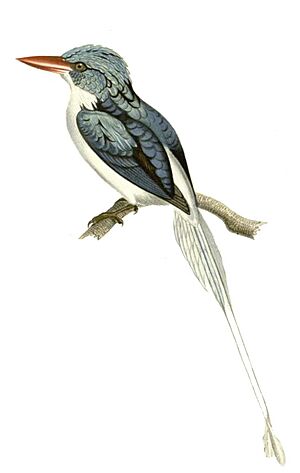Biak paradise kingfisher facts for kids
Quick facts for kids Biak paradise kingfisher |
|
|---|---|
 |
|
| Conservation status | |
| Scientific classification | |
| Genus: |
Tanysiptera
|
| Species: |
riedelii
|
The Biak paradise kingfisher (Tanysiptera riedelii) is a beautiful bird that belongs to the tree kingfisher family. It is only found on the Indonesian island of Biak. This island is part of a small group in Cenderawasih Bay, near the northern coast of Papua.
This special bird has a bright turquoise-blue back. Its belly and long tail streamers are white. It also has a reddish beak. The Biak paradise kingfisher lives in forests. Experts at the IUCN say it is "near-threatened". This means it could become endangered if we don't protect its home.
What It Looks Like
An adult Biak paradise kingfisher is about 35 cm (14 inches) long. This measurement includes its very long tail. The top of its head, back of its neck, and upper body are a shiny turquoise-blue.
Its lower back and the base of its tail feathers are white. The feathers under its wings are black. The two middle tail feathers are super long. They have thin stems that widen out at the end, looking like little rackets! The bird's belly and chest are white. Its strong, pointed beak is red.
Where It Lives
The Biak paradise kingfisher lives only on Biak Island in Indonesia. Scientists believe these birds came from a few T. galatea birds long ago. These first birds arrived on Biak and became separated from their relatives on the mainland.
Over time, these isolated birds changed and developed into a new species. This happened because the first birds had enough differences among themselves. Their genes changed without new genes coming in from other birds. This allowed them to become a unique kind of kingfisher.
How It Lives
Not much is known about the Biak paradise kingfisher's daily life. However, scientists think it eats and acts much like its close relative. This relative is the common paradise kingfisher (Tanysiptera galatea). The common paradise kingfisher lives on the mainland of New Guinea.
The common paradise kingfisher likes to sit on a low branch in the forest. From there, it quickly swoops down. It catches insects and earthworms from the forest floor. These birds build their nests in tree holes. They might also use hollow branches or holes in termite nests found in trees.
Its Future
The Biak paradise kingfisher lives in a small area. But it is quite common on Biak Island. Its forest home is facing a threat from logging. Logging means cutting down trees for wood.
However, large parts of the island's forests have not been cut down yet. The kingfisher seems able to live in forests that are growing back after being cut. But it might need areas with tall trees to survive well. The International Union for Conservation of Nature believes the number of these birds is likely going down. Because of this, they have listed the Biak paradise kingfisher as "near-threatened".


